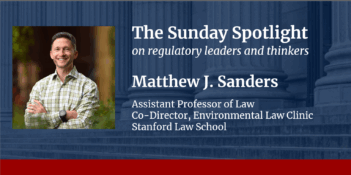
A Trump Administration proposal that would reduce the social cost of carbon relies on an unjustified discount rate.
When we perform cost-benefit analysis of regulations, and when the benefits of those regulations accrue in the future, we discount our estimates of the benefits so that we can quantify what should be spent today in order to avoid future damage. Regulation of carbon dioxide is a prime example. It persists in the atmosphere over many decades and causes global warming, which is itself a slow process with many effects having time lags of decades.
A recent article in Science warned that the incoming Trump Administration will try to revise the Social Cost of Carbon (SCC) that is used for cost-benefit analysis of a variety of regulations concerning global warming. The SCC is measured using a discount rate that purports to estimate the current value of future impacts, thereby allowing regulators to compare today’s costs more directly to tomorrow’s benefits. The Trump Administration’s likely increase in the discount rate from 2.5 percent to 5 percent could reduce the 2020 SCC from $62 to $12 per metric ton of carbon dioxide. A lower SCC, which suggests a lower value placed on preventing future damages, would imply that many current regulations appear to have costs that exceed their benefits.
What is the correct discount rate? I cannot answer that, but I can comment on the implications of some proposed reasons for discounting that are suggested by the large literature on this question in economics and philosophy. Further analysis of the arguments could lead to a more justified estimate of what the rate should be.
One reason that has been offered for discounting is that people in the future will be richer than we are now. Because money has “declining marginal utility,” people in the future, being richer, will value money less than we do. We must spend a larger proportion of our money on “necessities” that make a big difference in our lives, like food and shelter, while people in the future will spend more of it on “luxuries” that improve their well-being only a little. Thus, by discounting, we reduce the SCC and keep more money for ourselves, which does more good than by giving it to those who need it less.
But this assumption of increasing wealth could be incorrect. We cannot assume that the trend of only the last few centuries will always continue, and we have some reasons to think it will not, due to increasing population, a reduction in land area for farming, over-fishing, reduced supply of fresh water, sharply declining biodiversity, and global warming itself, which will lead to reduced land area for everything, among other problems. The argument from increasing wealth is thus weak, and the same line of reasoning could lead to the opposite conclusion if we are more pessimistic about the future.
Another argument for discounting is that we need to compare expenditures on some program, such as carbon regulation, to an alternative in which the money is invested in a way that helps those who would one day be hurt by climate change. In theory, we could set aside and invest money today and make sure that the proceeds go to those in need when the time comes. Or, instead of regulating carbon, we could take other steps to improve the economic development of poor countries, so that they could better prepare to deal with the effects of global warming. If the benefits of such alternative investment accrued over time at the rate of 5 percent, then regulation without such accrual over time would lose value over time at about that rate, by comparison with these alternatives. Using a 5 percent discount rate for the SCC thus ensures that we do not over-invest in regulation, relative to these alternatives.
A reply might be, “Why not do both?” In other words, let us regulate carbon and promote development, even if regulation is less efficient. Should we focus on one approach only? The argument for discounting answers this question: Any allocation to a less efficient approach would reduce overall efficiency.
If we are talking about small changes, then this argument makes sense. But two additional considerations come into play when we are talking about large changes in policy, at both the national level and especially the global level, where, as I have separately argued, U.S. policy can have a substantial influence on global policy.
One such consideration is that each dollar of additional expenditure produces less benefit, the more dollars are already being spent. As regulation becomes more stringent, it becomes increasingly costly to get the same additional benefit, so that the benefit per dollar decreases. This effect is already included in any cost-benefit analysis of regulation, without discounting. The same may be true of development assistance or expenditures for research on negative emissions, a term for removing carbon from the air. In the latter case, the number of researchers who know how to use additional money is limited. Because of these effects, putting the eggs in several baskets—that is, regulation, development assistance, and research—will surely do more good than putting all of them in one basket, especially given the low probability that even all these approaches together will be sufficient to avoid serious harm in the future.
A second consideration for large-scale allocation decisions involves uncertainty about benefits. If we guess wrong about these and put all our eggs in one basket, we may fail completely, which leads to very bad outcomes. Thus, diversification of approaches is also justifiable as insurance against being completely wrong. It is more likely that something will work, if we try many things. Moreover, it does seem that carbon regulation is more certain to have future benefits than either of the other approaches.
In sum, although the benefits of potential alternatives should be considered in the overall decision about allocating resources for dealing with climate change, it would be better to do this explicitly rather than through a discount rate based on questionable assumptions about alternatives. And allocation of additional resources to regulation does not necessarily imply that resources devoted to other approaches need to be reduced.
Another argument for discounting is “pure time preference,” the simple fact that people care less about the future than the present. We do this within our own lives, and it is difficult to say that it is irrational. Why should I care as much about my future self as about my present self? If I think of my future self as another person, then my lack of concern for him could be part of a lack of concern for other people in general, as opposed to my present self. I thus may want to discount the future of humanity because I discount other people more generally. This kind of discounting, too, may not be clearly irrational.
However, when we discuss regulatory policy, we are taking a societal perspective, in which I am just one of many billions who are affected. From this perspective, a preference for present people over future people becomes a form of moral prejudice, such as caring more about white people than black people. The same issue arises if we care more about co-nationals than about foreigners. From a moral and societal point of view, such preferences for unequal treatment are difficult to justify. If we end up doing so because our self-serving preferences express themselves in the behavior of citizens in a democracy, that is not a justification so much as an unpleasant fact.
We do have some good reasons for discounting at the level of policy. Uncertainty about future events gives us such a reason. There could be some technological advance that would solve the problem and make any present sacrifice fruitless. The Times of London, in 1894, predicted that New York City would be buried under nine feet of horse manure within about 50 years. By 1912, most horses had been retired. Or, humanity could be largely or completely wiped out by a nuclear war, an epidemic, or an asteroid. In this case, too, any sacrifice now would be for naught.
Even though uncertainty about future events does permit some discounting, it is difficult to say how much this should be. But it is surely at the low end of the range now being considered. It is hard to imagine what technological advance might quickly alleviate the problem. Even totally carbon-free energy generation would not do it, because of the carbon that is already in the air. And the chance of a civilization-destroying war or epidemic, while difficult to estimate, may also be low.
The sort of discounting justified by uncertainty, small as it may be, also serves to avoid another problem with zero discounting. If we do no discounting at all, we would need to consider irreversible effects of our actions now that would persist forever, such as loss of biodiversity. Biodiversity may or may not have much utility for humans now. But if we consider the fact that its loss is forever, and if we do not discount the future, then we should be putting all of our resources into the protection of biodiversity. This is not a problem we need to worry about, so long as we do some discounting.




